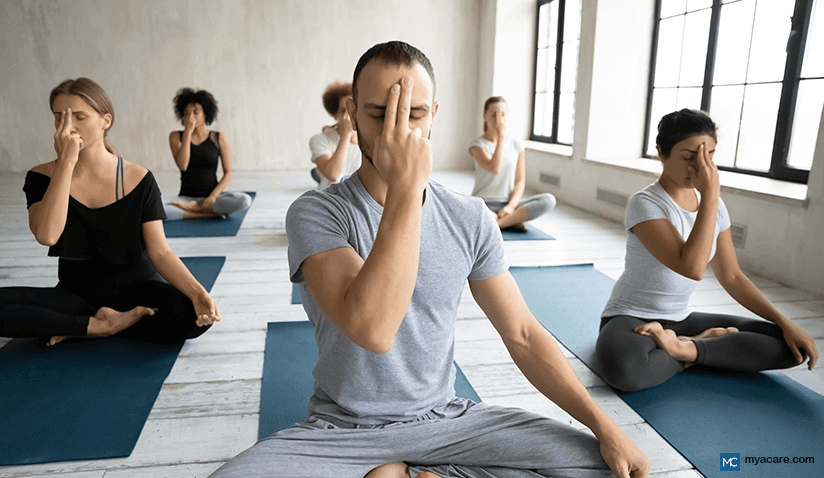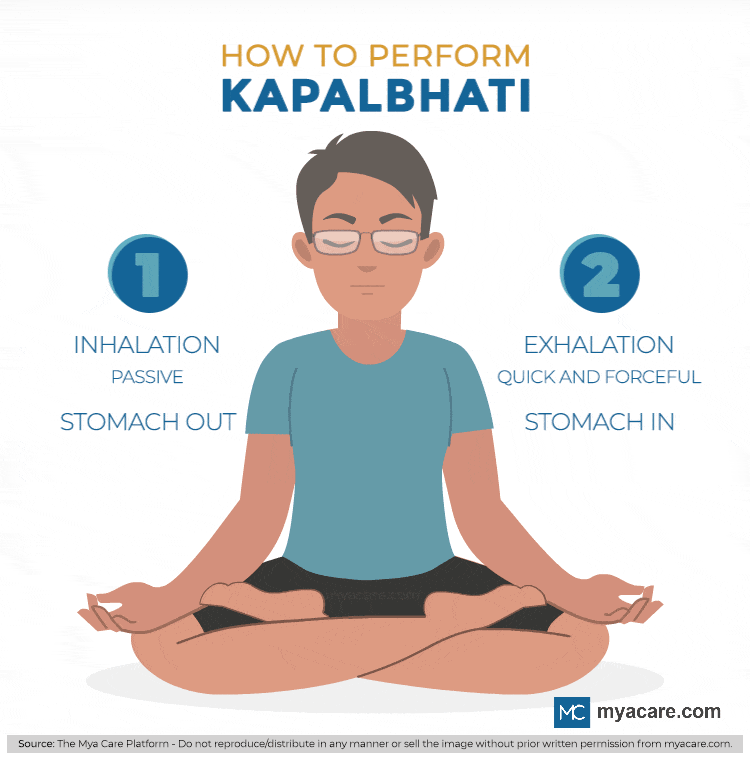How Yoga Helped Improve My Breathing Issues

Medically Reviewed by Dr. Rae Osborn, Ph.D. - November 5, 2024
As one of the founders of Mya Care, I have become more in tune with my health, having learned that to stay healthy, one should take charge of their health. As with many, breathing problems prevented me from fully embracing my health journey.
As a child, growing up with asthma sometimes proved to be challenging when playing sports or engaging in physically demanding activities. I was lucky to outgrow asthma for the most part, but I still experienced breathing difficulties due to reduced lung capacity. Later in adulthood, I learned that I had a deviated septum. A deviated septum is a condition in which the thin wall between the nasal passage, commonly known as the nasal septum is displaced to one side making one nasal air passage smaller than the other. The after-effects of childhood asthma, coupled with a deviated septum, impacted the healthy, active lifestyle I had chosen for myself.
In 2020, I was disappointed to score particularly low on my lung function test during my annual checkup. As a result, the doctors recommended inhalers to improve my symptoms. However, I quickly realized that this was only a temporary solution and needed to focus on a long-term fix.
I realized I needed to advocate for my own health. I knew I had to improve my respiratory fitness and general well-being. I discovered the benefits of pranayama (breathing exercises) and started working with a yoga teacher.
Now in 2022, my breathing feels better, I have more energy and I can accomplish more without feeling tired. My annual checkup showed significant improvements in my lung function test with above average results. This was even more surprising since I did the lung function test a week after recovering from COVID-19.
For these reasons and more, I want to share a little about pranayama and yoga to illustrate how it helps with breathing difficulties and enhances many aspects of health and well-being. My precedents are not designed to replace advice from a doctor but to share my experience on things that have helped me. Please always make sure to consult your doctor for any medical concerns.
What is Yoga?
Yoga is defined as a spiritual practice that emphasizes bridging the mind and body. The word Yoga means “to unite” or “to join,” and it is used to unite the body and mind, as well as to connect our material nature with our spiritual one. The practice of yoga is not bound by religion and is rather viewed as a tool that can benefit everyone. While Yoga has spiritual roots, it has become a widespread practice for promoting physical and mental well-being. There are dozens of yoga forms, each addressing different aspects of the mind and body to unite the two.
This ancient system of physical, mental and spiritual practices have been passed down through the generations. Yogic practices include postures, breathing exercises, relaxation techniques, chanting, and other forms of meditation.
What is Pranayama?
The yoga exercises that I have found the most helpful come under Pranayama. Pranayama means “breath control or regulation”, yet direct translations mean “life force/energy source control”. This shows the connection between the breath and the body’s ability to produce energy. I can certainly testify to how practicing Pranayama or breath control has helped to improve my respiratory health.
To further illustrate, here is a list of the breathing exercises I practice:
- Bhastrika. This pranayama exercise is designed to increase body heat by pushing air into the body in a controlled manner. Bhastrika translates to meaning “bellows”, as in the bellows of the blacksmith used to melt metal. Also known as the “breath of fire”, Bhastrika pranayama is a technique that involves quick inhalations and exhalations. Consider Bhastrika Pranayama the next time you feel your body needs more energy. It is used to “melt” or remove blockages from the circulation, respiratory and digestive tracts, which enhances their functions.[1]
- Kapalbhati. It is an element of the yogic body cleaning system known as shat kriya. This breathing exercise attempts to purify the mind and is used for enhancing cognition and mental health. The name Kapalbhati means “shining forehead”. It is perhaps one of the most straightforward pranayama breathing exercises in which one exhales deeply with assistance from the navel.[2] One of the unique advantages of Kapalbhati is that it enhances your lungs' capacity and makes them stronger. The kapalbhati breathing benefits include:
- Soothing the sinus and controlling asthma
- Enhancing kidney and liver function
- Improving blood circulation and digestion
- Fostering better sleep patterns

- Ujjayi. This technique of breath means - breath of victory / ocean breath, as the movement of air in the glottis (throat) resembles the sounds of waves of the ocean. This technique builds heat in the body and relaxes the mind. It helps in clearing the passage of the nostril and throat, reducing the accumulation of phlegm.[3]
- Sheetali. Unlike Bhastrika yoga, Sheetali pranayama exercises are aimed at cooling the body down, simultaneously soothing the mind and nerves. Sheetali translates to mean cooling or calm and passionless. Some Indian authorities recommended it during lockdown as a means for keeping one’s body stable and calm.[4] As it can cool the body down, it may also be useful for maintaining a constant temperature when running a fever.
- Nadi Shodi. Also known as Nadi Suddhi or Nadi Shodana, this pranayama exercise was created for the purification of the body’s energy centers. Nadi refers to the body’s energy pathways or centers, and Shodi or Suddhi refers to purification. Purification is achieved by alternating breathing through each nostril and using various hand postures. Attention shifts between the left and right sides of the body, and is thought to balance energy flow.[5] [6] It also trains one to breathe correctly through the nose.
- Brahmari. This pranayama technique derives its name from the Indian black bee, bramara. Just like a bumble bee, it involves humming a low tone during exhalation. It is known to calm both body and mind, dissolve anger or frustration, help one to fall asleep[7], and still the mind for meditation.[8]
These are examples of pranayama exercises. They are simple to follow, and as they do for many others globally , make a tremendous difference to my quality of life.
Benefits of Pranayama and Yogic Breathing Exercises
As the heart of pranayama is breath work, all pranayama exercises offer similar benefits with minor deviations.
A few of the benefits of pranayama and yogic breathing exercises are discussed below.
1. Improves breathing
Pranayama exercises have been shown to improve breathing in several ways. These include:
- Enhancing respiratory muscle activity and strength[9]
- Improving lung function in those with muscle dystrophy[10]
- Regulating heart rate[11] and cardiorespiratory function
- Lowering blood pressure and tension
- Increasing the expiration of CO2 per breath[12]
Opens the Airways. A lot of content online suggests that pranayama can lower mucus and inflammation in the respiratory tract[13], which opens the airways and naturally goes a long way toward breathing optimally. This has been verified in experimental scientific trials. Many who practice pranayama benefit in this way, including myself.
Aids Respiratory Symptoms. Those with breathing disorders were shown to benefit the most from pranayama yoga. Research indicates that pranayama yoga can reduce the severity and frequency of symptoms and respiratory medication requirements in those with asthma[14], chronic obstructive pulmonary disease, chronic sinusitis[15] and lung cancer.[16]
2. Helps Optimize Physical Performance
Yogic breathing has helped me with my athletic performance. For instance, I can cycle faster and for longer. Most of the benefits of improving one’s breathing with pranayama stem from the metabolic effects:
Metabolic Rate. Pranayama can change the oxygen consumption rate[17], depending on the exercise. As oxygen is a main component of cellular respiration, these fluctuations in consumed oxygen substantially impact our metabolic rate[18] and physical capacity. Studies show that exercises with alternate nostril breathing (i.e. nadi shodi pranayama) directly increase the metabolic rate, which can improve physical performance.[19]
Combats Exercise-Induced Fatigue. When we exercise, the body levels of inflammation increase. This is a natural part of muscle building. Post-workout pranayama was shown to lower the level of inflammation after exercise[20] as well as the associated fatigue.
Physical Yoga Practice Enhances Pranayama Benefits. A meta review reveals that yoga (of which pranayama is a component) is comparable to other forms of exercise[21] and can improve areas of physical fitness, including muscle strength, flexibility, and cardiorespiratory function.[22] Some of these benefits apply to those with arthritis[23] who could function better after practicing yoga for several weeks.
3. Augments Pain Perception
Pranayama is known to help lessen pain intensity through calming the body and mind[24]. By focusing on the breath, the mind can distance itself from its associations with pain, which helps reduce the perception of pain.
Painful Wounds and Injuries. In a group of 30 people with chest burn wounds, breathing exercises helped to reduce pain intensity, improved their ability to breathe, and helped them to participate in physical activity without as much difficulty.[25]
Chronic Pain. Pranayama techniques have also been shown to reduce pain intensity in those with chronic pain and pain-related disorders[26]. Small studies have confirmed this to be helpful for a few individuals with multiple sclerosis[27] and fibromyalgia[28]. In combination with yogic exercises, pranayama may also help reduce pain intensity for those with arthritis and other musculoskeletal conditions[29], including muscle dystrophy[30].
4. May Improve Cognition
There are a few studies that show how different pranayama exercises can enhance specific aspects of cognition[31].
Mental Reaction Time and Processing. Most of the benefits pertain to improvements in mental reaction times[32] which help the participants to accomplish tasks quicker and with less error. Some of the exercises helped patients who suffered from strokes recover better, particularly in cases where language ability became compromised.[33]
Brain Activation. Some studies have suggested that the way in which air flows through the nose impacts brain activity[34] and may influence which side of the brain is most active at any given time. Pranayama breathing exercises that work with nasal airflow have been shown to activate the brain, improve cognition and help to promote symmetrical brain activity.[35]
5. Lowers Anxiety
Yogic breathing exercises and other types of deep breathing exercises are well-known for calming the nerves and helping reduce anxiety[36]. It has helped me to be more stress resilient as well.
Calms the Stress Response. On a physical level, various types of pranayama have been shown to lower the neurological response to stress in healthy subjects by decreasing sympathetic nervous system activity and blood pressure.
Increases Stress Tolerance. The stress-related benefits of pranayama also apply to patients with generalized anxiety disorder. One study shows that pranayama improved symptoms and enhanced tolerance towards situations that give rise to anxiety.[37]
6. Immune Function Enhancement
Some studies suggest that pranayama yoga can benefit the immune system[38] , particularly in the face of stress-related changes to immunity.
Limited evidence reveals that pranayama may be able to[39]:
- Reduce a few markers of inflammation[40]
- Increase the lifespan of white blood cells
- Regulate stress and enhance immune system function
- Elevate the number of immune cells, including lymphocytes, such as natural killer cells[41]
7. Better Sleep Quality
Breathing difficulties can interfere with deep sleep and cause sleep disruptions, much like what I experienced before taking up pranayama practice seriously. Those with breathing problems often live with sleep disturbance which breathing exercises can help improve, as explained below.
Deep Sleep Requires Deep Breathing. Unobstructed breathing is a central component enabling deep sleep and waking up feeling well-rested. When we sleep, the heart rate slows along with our breathing. Deep sleep encourages cerebral fluids to penetrate the brain more deeply, allowing nutrients to get there and for toxins to get removed. When the brain enters this state of deep sleep, memories in the brain and body are consolidated which is crucial for learning and remembrance[42] .
Sleep Apnea is a classic example of a breathing disorder in which sleep is compromised. Deep breathing exercises are often prescribed to those with sleep apnea in an effort to promote better use of the respiratory muscles and better bodily airflow. Pranayama has been shown to have a similar efficacy to these deep breathing exercises, capable of improving sleep quality in those with sleep apnea by enhancing respiratory function.[43]
Jala Neti Kriya
In addition to breathing exercises. Neti Kriya, a yogic practice to cleanse the sinuses and nasal passages can be useful in keeping the body clean, robust, and healthy.
Do I Need a Teacher to Learn Yoga?
One can always learn yoga online by reading or watching videos, yet your success will depend on how well the content you find can explain the process. It is generally better to rely on a teacher to introduce you to yoga and to monitor your practice, as mistakes are easily made. For example, during Kapalbhati it is important to focus on exhalation, but many new to yoga may forcefully inhale without realizing it. Beginners that look online may also miss important information, such as knowing how other muscles (like the abdominal muscles) should be involved in the technique.
Conclusion
Breathing difficulties are common across the population and can substantially affect the quality of life. Even when nothing can be done about the cause, there are still options for improving one’s ability to breathe. With pranayama yoga, I am scoring better on my lung function test than ever before, despite having a deviated septum (and even COVID-19 a week before the test).
Pranayama helps you train to breathe properly, increasing the fitness of the lung muscles and enhancing overall lung function. It is an extremely calming practice that lowers pain and stress, increases energy levels, and helps to improve multiple areas of health that are connected to breathing.
To search for the best doctors and healthcare providers worldwide, please use the Mya Care search engine.
Manish Menda is one of the Co-Founders of Mya Care. He has a Bachelor of Business Administration from Washington University in St. Louis and a Master of Business Administration from Saïd Business School, University of Oxford. Manish is an avid entrepreneur and pioneered patient financing in India. Manish and his family founded Mya Care with the intention to empower patients and give them the tools they need to find health and wellness services for their specific needs around the world. Manish leads an active lifestyle, and his hobbies include cycling, hiking, padel tennis, swimming, weight training and yoga.

Dr. Rae Osborn has a Ph.D. in Biology from the University of Texas at Arlington. She was a tenured Associate Professor of Biology at Northwestern State University, where she taught many courses to Pre-nursing and Pre-medical students. She has written extensively on medical conditions and healthy lifestyle topics, including nutrition. She is from South Africa but lived and taught in the United States for 18 years.
Sources:
Featured Blogs



